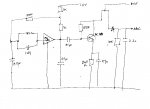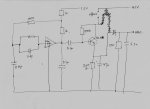I am building a wire guided robot. I have a transmitter based on an oscillator currently running at 80kHz on the wire. With suitable choice of coil & cap and inc my oscillator to 150Khz or greater can I use the MK484 radio Ic chip to tune into the signal in the wire, amplify it using a transistor, and use a comparator on two such circuits to control my robot?
I want to do this this way because I am not experienced enough with analogue electronics and this chip gives me detection, amplification and gain control.
http://www.rapidonline.com/resources/docs/82-1026.pdf
Transmitter power is 120 mA at 50% duty cycle and 12 V. I can tweak as required.
I am OK with using op amps to amplify the signal but using op amps I can only find the wire at about 5cm. Increasing power isn't an efficient or elegant way to improve detection range because of the inverse sq rule. So I want to increase sensitivity 6 fold by using an off the shelf package like the MK484.
I need to detect the wire at about 30 cm distance and use the signal strength to follow the wire with a two sensors a la a line following robot.
I am a bit confused about how the sensitivity of the detector. Will the proximity to the wire be the RMS voltage output of the IC (op amp or Mk484)? If the IC tunes in to my signal will it be the same RMS output at 30 cm and 5 cm? If so how do I measure proximity?
Will a simple inductor be OK or do I need the full ferrite rod arrangement?
I want to do this this way because I am not experienced enough with analogue electronics and this chip gives me detection, amplification and gain control.
http://www.rapidonline.com/resources/docs/82-1026.pdf
Transmitter power is 120 mA at 50% duty cycle and 12 V. I can tweak as required.
I am OK with using op amps to amplify the signal but using op amps I can only find the wire at about 5cm. Increasing power isn't an efficient or elegant way to improve detection range because of the inverse sq rule. So I want to increase sensitivity 6 fold by using an off the shelf package like the MK484.
I need to detect the wire at about 30 cm distance and use the signal strength to follow the wire with a two sensors a la a line following robot.
I am a bit confused about how the sensitivity of the detector. Will the proximity to the wire be the RMS voltage output of the IC (op amp or Mk484)? If the IC tunes in to my signal will it be the same RMS output at 30 cm and 5 cm? If so how do I measure proximity?
Will a simple inductor be OK or do I need the full ferrite rod arrangement?



